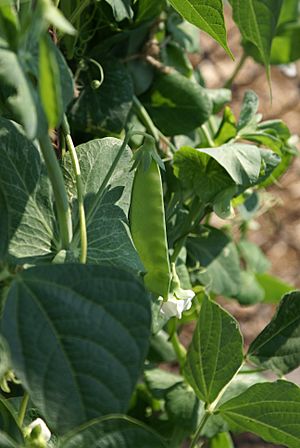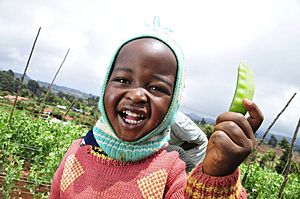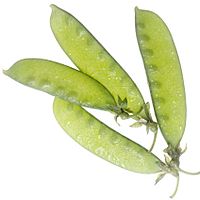Snow pea facts for kids
Quick facts for kids Snow pea |
|
|---|---|
 |
|
| Species | Pisum sativum |
| Cultivar group | Macrocarpon Group |
| Cultivar group members | Many; see text. |
The snow pea is a type of pea that you can eat whole, including its flat, thin pod. People usually eat them when they are still young and unripe.
Contents
What Are Snow Peas Called?
The name snow pea might seem a bit odd because these peas are not planted any earlier than other types of peas. Another common name is Chinese pea. This name probably comes from how often snow peas are used in Chinese dishes served in Western countries.
In French, snow peas are called pois mangetout, which means "eat-all pea." This name can also be used for snap peas, which are similar.
Snow peas and snap peas both belong to a group called Macrocarpon Group. This group is based on a specific type of pea called Pisum sativum var. macrocarpum, which was first described in 1825. This type of pea was known for having flat, edible pods that were not tough.
Sometimes, the scientific name Pisum sativum var. saccharatum is incorrectly used for snow peas. However, this name actually describes a different kind of pea with slightly tougher pods. Because of this, scientists now use Pisum sativum var. macrocarpum as the correct name for snow peas.
Snow Peas as Food
Snow peas are special because, like sugar snap peas, their pods are completely edible. Unlike other peas, such as field peas or garden peas, snow pea pods do not have a tough, stringy layer inside. This tough layer is made of a material called lignin.
Snow peas have thinner walls than sugar snap peas. Two special genes are responsible for making the pods edible and thin. One gene helps reduce the tough inner layer, and the other makes the pod walls thinner.
The young stems and leaves of the snow pea plant are also used in cooking, especially in Chinese dishes. They are often stir-fried with garlic and sometimes mixed with crab or other seafood.
|
Snow peas (Pisum sativum)
|
|
| Nutritional value per 100g | |
|---|---|
| Energy | 176 kJ (42 kcal) |
|
7.55
|
|
| Sugars | 4.00 |
| Dietary fiber | 2.6 |
|
0.3
|
|
|
Protein
|
2.8
|
| Vitamins | Quantity
%DV†
|
| Vitamin A equiv.
beta-Carotene
lutein zeaxanthin
|
6%
630 μg740 μg
|
| Vitamin A | 1087 IU |
| Thiamine (B1) |
13%
0.150 mg |
| Riboflavin (B2) |
7%
0.08 mg |
| Niacin (B3) |
4%
0.6 mg |
| Pantothenic acid (B5) |
15%
0.75 mg |
| Vitamin B6 |
12%
0.16 mg |
| Folate (B9) |
11%
42 μg |
| Vitamin B12 |
0%
0 μg |
| Choline |
4%
17.4 mg |
| Vitamin C |
72%
60 mg |
| Vitamin D |
0%
0 μg |
| Vitamin E |
3%
0.39 mg |
| Vitamin K |
24%
25 μg |
| Minerals | Quantity
%DV†
|
| Calcium |
4%
43 mg |
| Iron |
16%
2.08 mg |
| Magnesium |
7%
24 mg |
| Manganese |
12%
0.244 mg |
| Phosphorus |
8%
53 mg |
| Potassium |
7%
200 mg |
| Sodium |
0%
4 mg |
| Zinc |
3%
0.27 mg |
| Other constituents | Quantity |
| Water | 88.89 |
| †Percentages estimated using US recommendations for adults. | |
How Snow Peas Help Soil
Like most legumes (plants that grow in pods), snow peas have special helpers in their roots. These helpers are tiny bacteria called rhizobia. They live in small bumps on the roots called root nodules.
These bacteria take nitrogen from the air and turn it into a form that plants can use in the soil. This is a mutualistic relationship, meaning both the pea plant and the bacteria benefit. Because of this, snow peas are great to grow alongside other plants, especially leafy vegetables. These vegetables need a lot of nitrogen to grow strong and green.
Growing and Storing Snow Peas
Snow peas can be grown outdoors when the weather is cool. This means they can be planted during winter and spring.
To keep snow peas fresh longer, they can be stored in special plastic films at about 5°C (41°F). Controlling the amount of oxygen and carbon dioxide around them also helps them stay fresh and look good.
Gallery





